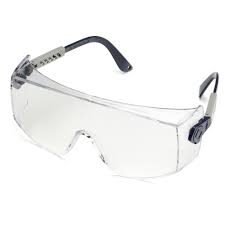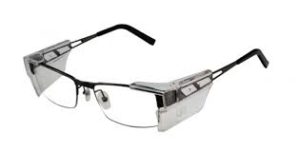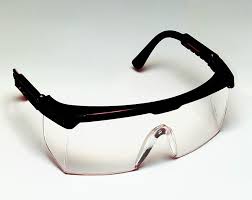Safety eyewear for workers who wear glasses or contact lenses 
If your work exposes your eyes to hazards such as dust or chemicals, or to the risk of impact with tools, materials,
or flying debris, you must wear safety eyewear. This requirement also applies to workers who wear prescription
glasses or contact lenses. Regular prescription glasses or contact lenses are not a substitute for safety eyewear.
Eyewear options.
The two main choices for workers who wear prescription glasses or contact lenses are
• Wearing non-prescription safety eyewear (glasses or goggles) over your own prescription glasses or contact lenses
• Wearing prescription safety eyewear
In order to determine which options are appropriate for you, your employer
must assess the hazards of your workplace and your job. Here are some key
factors for consideration:
• If you are exposed to hazards from the side, your safety eyewear must
have side shields or wraparound arms.
• If there is a risk of impact to your eyes, your safety eyewear must have
polycarbonate or plastic lenses.
• If you are exposed to high temperatures or corrosive chemicals,
polycarbonate or plastic lenses may not be practical. In such cases, lenses made of treated safety glass may be acceptable, as long as there is no risk of impact to your eyes.
• If there is a risk of injury to other parts of your face, you must wear a
face shield over your safety eyewear.
• If you work in dry, dusty, or chemically charged environments, contact
lenses may not be suitable, even when worn with safety eyewear.
Standards for eye and face protection
Check that your safety eyewear and face protection has markings indicating
that it meets CSA or ANSI requirements.
• On non-prescription safety eyewear or face shields, look for these markings: CSA or ANSI Z87. For protection
from high impact, choose eyewear marked CSA or ANSI Z87+.
• On prescription safety eyewear made of polycarbonate or plastic look for CSA. On prescription lenses made of
treated safety glass, look for ANSI Z87-2. Note: Wearing lenses made of treated safety glass is acceptable only
when polycarbonate or plastic lenses are not practical and there is no risk of impact to your eyes.
Who pays for safety eyewear?
• Employers must provide and pay for non-prescription safety eyewear.
• Employers are not required to pay for prescription safety eyewear. Workers who prefer wearing prescription
safety eyewear may have to pay for it themselves.
Remember: Safety eyewear can’t protect you unless you wear it.
For more information, go to worksafebc.com, Occupational Health and Safety Regulation, 8.14 to 8.18 (Eye and Face Protection).
